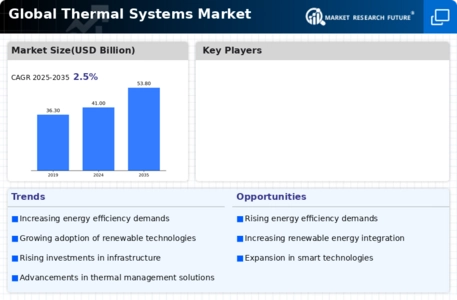Market Share
Thermal Systems Market Share Analysis
In the Thermal Systems Market, companies employ diverse strategies to secure and enhance their market share positioning. One fundamental approach is differentiation through technological innovation. Companies strive to develop and introduce advanced thermal systems that outperform competitors in terms of efficiency, sustainability, and smart features. By staying at the forefront of technological advancements, businesses can carve a niche for themselves and attract customers looking for cutting-edge solutions.
Pricing strategies also play a pivotal role in market share positioning. Some companies opt for cost leadership, offering thermal systems at competitive prices to gain a larger market share. Others focus on premium pricing, emphasizing superior quality and advanced features to target a more exclusive segment of the market. Striking the right balance between pricing and perceived value is crucial for companies seeking to position themselves effectively in the competitive Thermal Systems Market.
Strategic partnerships and collaborations are increasingly becoming a favored tactic in the thermal systems industry. Companies forge alliances with other businesses, research institutions, or technology providers to enhance their capabilities, access new markets, and share resources. Collaborative efforts can result in the development of innovative products or the creation of synergies that strengthen a company's market share positioning.
Market segmentation is another key strategy employed in the Thermal Systems Market. By identifying and targeting specific customer segments with tailored products, companies can address diverse needs and preferences effectively. This strategy allows businesses to optimize their marketing efforts, streamline product development, and build a more loyal customer base within their chosen market segments.
Investments in marketing and brand building are essential for companies vying for a robust market share. Building a strong brand presence helps create brand loyalty among consumers, making them more likely to choose a particular company's thermal systems over competitors. Effective marketing campaigns, online presence, and customer engagement contribute significantly to brand recognition and influence purchasing decisions.
Continuous improvement and adaptation to market trends are critical strategies for maintaining and expanding market share in the Thermal Systems Market. Companies that invest in research and development, monitor industry trends, and swiftly respond to changing consumer preferences position themselves as leaders in the market. This proactive approach allows businesses to stay ahead of the competition and maintain a strong market share over the long term.
Customer service and post-sales support also play a vital role in market share positioning. Companies that prioritize customer satisfaction and offer excellent support services tend to build a positive reputation and gain repeat business. Satisfied customers are more likely to recommend a company's products to others, contributing to the growth of its market share.
Lastly, geographical expansion and market diversification strategies contribute to market share growth. Companies may explore untapped markets, both domestically and internationally, to expand their customer base. Diversifying product offerings to cater to a broader range of applications and industries also helps companies capture a larger share of the thermal systems market.



Leave a Comment